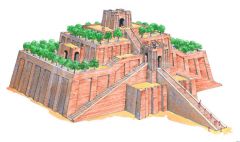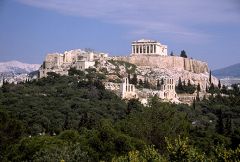![]()
![]()
![]()
Use LEFT and RIGHT arrow keys to navigate between flashcards;
Use UP and DOWN arrow keys to flip the card;
H to show hint;
A reads text to speech;
59 Cards in this Set
- Front
- Back
|
the study of past societies through an analysis of the items people left behind them
|
archeology |
|
|
A(n) __________ is a complex culture in which large numbers of human beings share a number of common elements.
|
civilization |
|
|
the study of human of human life and culture based on artifacts and human fossils
|
anthropology |
|
|
Neanderthals were probably the first of the early humans to __________
|
bury their dead |
|
|
Which of the following skills was part of the Paleolithic way of life? |
detailed cave paintings |
|
|
What made it necessary to expand governments?
|
the need to maintain food supplies
|
|
|
The Neolithic Revolution __________
|
was a result of systematic agriculture.
|
|
|
Craft specializations emerged as a result of __________
|
the trading of goods |
|
|
type of Homo sapiens that lived in Europe and the Middle East between 100,000 and 30,000 B.C.
|
Neanderthals |
|
|
The earliest governments are best described as __________
|
monarchies |
|
|
Where and when did the first Homo sapiens sapiens appear?
|
Africa; 150,000–200,000 years ago
|
|
|
Australian aborigines belong to the __________ subgroup.
|
Homo sapiens sapiens
|
|
|
The first civilizations developed in __________
|
river valleys.
|
|
|
humans and other human-like creatures that walk upright
|
hominids |
|
|
Cyrus was called “the Great” because he __________
|
showed unusual wisdom and compassion.
|
|
|
The land between the Tigris and Euphrates Rivers was known as __________
|
Mesopotamia |
|
|
Most of the people in Egyptian society were __________
|
peasants |
|
|
a high government official in ancient Egypt or in Muslim countries
|
vizier |
|
|
The basic unit of Sumerian civilization was the __________
|
city-state |
|
|
government by divine authority
|
theocracy |
|
|
a massive stepped tower on which was built a temple dedicated to the chief god or goddess of a Sumerian city
|

ziggurat
|
|
|
According to their history, the Israelites originally migrated to Palestine from __________
|
Mesopotamia |
|
|
According to the Code of Hammurabi, if a building collapsed and killed the son of the building's owner, __________
|
the builder's son could be put to death.
|
|
|
Pharaohs of the Middle Kingdom were seen as __________
|
shepherds of their people.
|
|
|
Pyramids were designed primarily as __________
|
burial places for pharaohs.
|
|
|
"wedge-shaped", a system of writing developed by the Sumerians using a reed stylus to create wedge-shaped impressions on a clay tablet
|
cuneiform
|
|
|
The invention of the __________ made it easier for Sumerians to transport goods.
|
sundial
|
|
|
The Phoenician culture was best known for its __________
|
alphabet |
|
|
Ancient Egypt was distinguished from Mesopotamia by __________
|
natural barriers against invasion.
|
|
|
The teachings of Siddhartha Gautama are the basis of __________
|
Buddhism |
|
|
______________ is considered the originator of Daoist thought.
|
Laozi |
|
|
__________ hastened the collapse of most Chinese dynasties.
|
Rebellions, invasions, and the declining power of the central government. |
|
|
Samudragupta expanded the __________ empire.
|
Gupta |
|
|
The early Hindu God was called __________
|
Brahman |
|
|
one of the five major divisions of Indian classes in ancient times: Brahmans, Kshatriyas, Vaisyas, Sudras, and Untouchables
|
caste |
|
|
According to Buddhism, wisdom leads to __________
|
nirvana
|
|
|
Confucianism, Daoism, and __________ are three major Chinese schools of thought that emerged between 500 and 200 B.C.
|
Legalism
|
|
|
Under the Han, the Chinese invented __________
|
Paper |
|
|
The __________ is considered the longest poem ever written.
|
Mahabharata
|
|
|
__________ civilization was centered around the cities of Harappa and Mohenjo-Daro.
|
Indus |
|
|
Traders on the Silk Road carried primarily __________
|
luxury goods |
|
|
The Aryan caste system included all of the following except __________
|
Guptas |
|
|
a Chinese Buddhist monk who traveled through the Gupta Empire and admired the character of their rule and their tolerance of Buddhism
|
Faxian |
|
|
The Mauryan Empire flourished under __________
|
Asoka |
|
|
After defeating a Persian army at Issus, Alexander did what?
|
expanded his empire as far as modern Pakistan, built Alexandria, the Greek capital of Egypt, Defeated Persians in a battle near babylon |
|
|
During the Age of Pericles, the Athenians became deeply attached to their political system of __________
|
direct democracy |
|
|
The Greek city-states relied on infantrymen called __________ for their defense.
|
hoplites
|
|
|
why did Alexandria stand out among other Hellenistic cities
|
home for scholars of all kinds library a museum for research |
|
|
The Minoan civilization, which flourished between 2700 and 1450 B.C., was established
|
on Crete |
|
|
__________, one of the early Greek philosophers, taught that the essence of the universe could be found in music and numbers.
|
Pythagoras |
|
|
in early Greek city-states, an open area that served as a gathering place and as a market
|
agora |
|
|
A turning point in the Great Peloponnesian War came when __________
|
Sparta destroyed the Athenian fleet.
|
|
|
in ancient Greece, a sacred shrine where a god or goddess was said to reveal the future through a priest or priestess
|
Oracle |
|
|
in early Greek city-states, a fortified gathering place at the top of a hill which was sometimes the site of temples and public buildings
|

Acropolis |
|
|
why did Greek culture spread in Southwest Asia during the Hellenistic Era?
|
Greek administrators, architects, actors, and others moved to the new Greek cities.
All government business was transacted in Greek rather than native languages. Hellenistic rulers encouraged a massive spread of Greek colonists to Southwest Asia. |
|
|
In order to learn the will of the gods, the Greeks __________
|
made use of oracles |
|
|
a defensive alliance against the Persians formed by Athenians.
|
Delian League |
|
|
__________, by Aeschylus, is the only complete Greek trilogy we possess today.
|
The Oresteia
|
|
|
A group of five men, ephors were __________ leaders in Sparta responsible for the education of youth and the conduct of all citizens.
|
elected |

